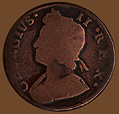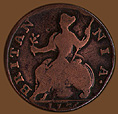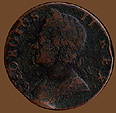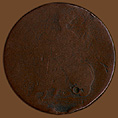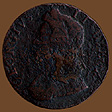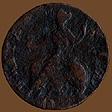Counterfeit British Coppers
George II
FARTHING
obverse |
|
reverse |
| |||
Farthing 1754 George II cast counterfeit
Obverse: GEORGIVS II . REX .
Reverse: BRITAN NIA 1754
Weight: 54.0 g (3.50 grams) Diameter: 23.5 mm
Comments: The obverse bears a portrait of George II, facing left as in the regal issue, while the reverse bears a Britannia design. This example is 20% under the minimum acceptable weight of 69.6 grains. Also, as it has a extremely pitted and rough surface with indistinct details I have designated it as a cast copy. Like most cast coins it is made from mixed metals and has an unusual "tin" ring to it. The final numeral of the date is unclear on the coin. This coin uses the George II farthing third obverse design. This obverse can be distinguished in that GEORGIVS has a V with a rather thin and slightly rounded upstoke. The third obverse was used in 1746, 1749, 1750 and 1754. [Obverse one, used from 1730-1739 has a very pointed V with a straight upstroke, while obverse two, used 1741 and 1744 has a U]. This example appears to be dated 175- with the last numeral being the right portion of a numeral 4. Royal 1754 farthings were struck for several years and quite likely an example was used to create the mold from which the present coin was produced.
Provenance: Donated to Notre Dame in 1887 as part of a 2,300 item coin collection (see: The Notre Dame Scholastic, vol. 21 (September 1887) 45.
HALFPENCE
obverse |
|
reverse |
| |||
Halfpenny 1736 George II counterfeit
Obverse: GEORGIVS . II . R E X .
Reverse: BRITAN N I A .
Weight: 132.5 g (8.59 grams) Diameter: 27.8 mm
Comments: The obverse bears the younger portrait of George II facing left while the reverse appears to be the first Britannia design with part of the date visible. This halfpenny is only 5% under the minimum acceptable weight of 140 grains. As most George II halfpence weight between 150 and 165 grains I suspect this is a rather heavy counterfeit.
Provenance: Donated to Notre Dame in 1887 as part of a 2,300 item coin collection (see: The Notre Dame Scholastic, vol. 21 (September 1887) 45.
obverse |
|
reverse |
| |||
Halfpenny 1740 George II cast counterfeit
Obverse: GEORGIUS . II . R E X .
Reverse: BRITAN N I A .
Weight: 165.2 g (10.70 grams) Diameter: 27.63 mm
Comments: It exhibits the standard features of a cast counterfeits, with a very rough surface having many indistinct features. Also, as is usual for cast coins, it appears to be composed of mixed metals as it has an unusual "lead" ring to it, indeed the coin propably has a high lead content as it is quite heavy for a halfpenny. The casting ports are visible at 3:00 and 7:00 o'clock on the obverse. The final numeral of the date is not fully visible but it must be 0. The obverse bears the older portrait of George II facing left with the use of the U in GEORGIUS, which categorizes it as the second obverse. The coin used to produce the mold for this counterfeit was therefore made from a second reverse variety, which was produced 1740-1745. Thus it appears the final numeral must be a zero rather than a nine. For a 1200 dpi detail of the date area on this cast coin click here.
Provenance: Donated to Notre Dame in 1887 as part of a 2,300 item coin collection (see: The Notre Dame Scholastic, vol. 21 (September 1887) 45.
obverse |
|
reverse |
| |||
Halfpenny George II undated counterfeit
Obverse: [GEORGI]VS . II [. R E X .]
Reverse: [BRITAN] [N I A .]
Weight: 121.6 g (7.87 grams) Diameter: 28.58 mm
Comments: The obverse bears what appears to be the younger portrait of George II with only a small part of the legend visible. This is obverse 1, which was used 1729-1739. The reverse shows the Britannia design without a visible legend or date. This halfpenny is about 14% under the minimum acceptable weight of 140 grains.
Provenance: Donated to Notre Dame in 1887 as part of a 2,300 item coin collection (see: The Notre Dame Scholastic, vol. 21 (September 1887) 45.
obverse |
|
reverse |
| |||
Halfpenny George II undated cast counterfeit
Obverse: GEORGIVS . II . R E X
Reverse: BRITAN N I A .
Weight: 118.0 g (7.64 grams) Diameter: 28.0 mm
Comments: The obverse bears a portrait of George II facing left while the reverse bears a Britannia design without date. This lightweight halfpenny is a little more than 15% under the minimum acceptable weight of 140 grains. It exhibits the standard features of a cast counterfeits, with a very rough surface having many indistinct features. Also, as is usual for cast coins, it appears to be composed of mixed metals as it has an unusual "lead" ring to it. The obverse legend uses the V in GEORGIVS. This coin appears to have been made from a casting produced from a George II halfpenny with the third obverse combined with the second reverse, regal halfpence of this type were produced 1746-1754.
Provenance: Donated to Notre Dame in 1887 as part of a 2,300 item coin collection (see: The Notre Dame Scholastic, vol. 21 (September 1887) 45.
| Regal Irish Coppers: p.2 | Section Contents | Counterfeit British Coppers: p. 2 |
|
For viewing tips and information on optimal computer settings click
here.
For questions or comments contact Special Collections by: |


